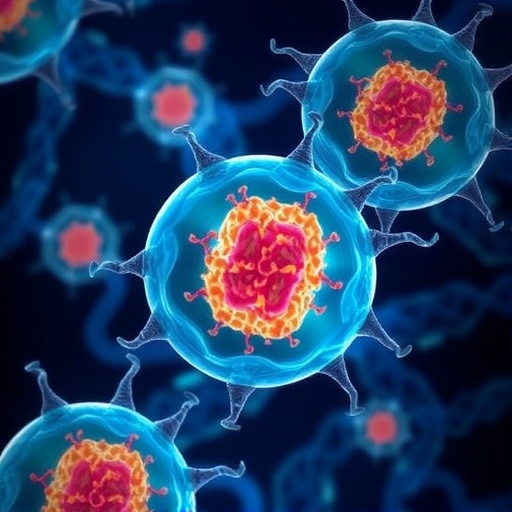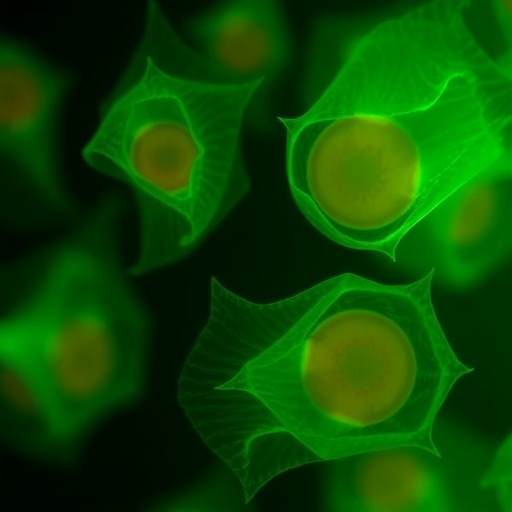
In the ever-complex realm of metabolic health, the development and function of adipose tissue stands as a critical determinant of overall physiology. Excess fat accumulation is a notorious harbinger of multiple diseases, including diabetes and cardiovascular conditions, but the cellular and molecular mechanisms that dictate how fat cells—adipocytes—originate and mature have remained elusive. A transformative study spearheaded by researchers from the University Hospital Bonn (UKB) and the University of Bonn now unveils groundbreaking insights into this process, illuminating how the tiny cellular antennae known as primary cilia orchestrate the fate of adipocyte precursor cells. This discovery not only deepens our understanding of adipose tissue biology but also charts an unprecedented course toward potential therapeutic interventions for obesity and its related disorders.
Adipose tissue is far from a passive fat reservoir; it is a dynamic, metabolically active organ that plays a vital role in energy storage and homeostasis. Central to the adaptability of white adipose tissue is its stem cell-like precursor population, cells capable of differentiating into mature adipocytes or alternatively into connective tissue-like cells. These precursor cells harbor a highly specialized organelle—the primary cilium—that functions as a signaling hub interacting with the cellular environment. Acting much like an antenna, primary cilia detect and transduce extracellular cues, thereby directing cellular signaling pathways critical for determining cell fate. Understanding how these signaling pathways influence adipocyte precursors remains paramount for comprehensively addressing obesity from a cellular programming perspective.
The study focused on the impact of primary cilia dysfunction within adipocyte precursors using a genetically engineered mouse model that mimics Bardet-Biedl syndrome (BBS), a disorder characterized by ciliary defects and known association with obesity. The research team centered their investigation on BBS8, a pivotal ciliary protein whose absence models the dysfunctional cilia state seen in BBS. Intriguingly, the researchers observed that deficiency of BBS8 disrupts the primary cilium’s role in controlling key signaling cascades, driving fat precursor cells toward an aberrant developmental path.
.adsslot_LrEKHlIghW{width:728px !important;height:90px !important;}
@media(max-width:1199px){ .adsslot_LrEKHlIghW{width:468px !important;height:60px !important;}
}
@media(max-width:767px){ .adsslot_LrEKHlIghW{width:320px !important;height:50px !important;}
}
ADVERTISEMENT
One of the most compelling findings was the identification of the Hedgehog signaling pathway as a critical mediator in this process. Under normal physiological conditions, Hedgehog signaling is tightly regulated by primary cilia to maintain a balance between differentiation into adipocytes versus other mesenchymal lineages. Overactivation of this pathway, as a consequence of ciliary dysfunction, coerces the precursor cells to deviate from their destiny as fat cells, pushing them instead towards a connective tissue-like phenotype. Such cells mirror those involved in fibrotic scar tissue formation, contributing to increased tissue rigidity, which in adipose tissue could impair its metabolic flexibility and functionality.
This aberrant lineage commitment was evident even before the overt manifestation of obesity in the BBS model mice, revealing previously unappreciated early remodeling events in adipose tissue. The reduction in stem cell-like precursors concurrent with enhanced differentiation toward connective tissue-like cells signifies a foundational remodeling process that precedes and potentially precipitates pathological fat accumulation and metabolic dysfunction. These insights pivotally suggest that primary cilia and Hedgehog pathway regulation form an early checkpoint in adipose tissue homeostasis.
Beyond the immediate implications for BBS, this research profoundly expands our understanding of ciliary biology in metabolic health. Primary cilia serve as pivotal organizers of intracellular signaling pathways, and their integrity is crucial not only for cellular communication but also for preserving the functional plasticity of precursor populations. The disruption of ciliary signaling cascades may therefore represent a previously underappreciated mechanistic underpinning of obesity and associated metabolic diseases, underscoring the need to consider cilia-targeted strategies in therapeutic development.
The elucidation of Hedgehog signaling’s overactivation as a driver of precursor cell fate misprogramming also opens exciting avenues for pharmacological intervention. Modulating this pathway with precision could theoretically restore the balance, favoring adipocyte differentiation and sustaining healthy adipose tissue. Such interventions could potentially halt or even reverse maladaptive remodeling processes that lead to metabolic disease, highlighting the translational impact of the current study.
Prof. Dagmar Wachten, whose leadership was instrumental in guiding this investigation, emphasizes the broader significance of these findings. The regulation of adipocyte precursors by primary cilia is not merely a cellular curiosity but a decisive factor in the systemic consequences of metabolic health. With obesity reaching epidemic proportions worldwide, identifying fundamental mechanisms that govern fat tissue integrity has never been more pressing. This research positions ciliary biology at the nexus of this critical challenge.
Notably, the study benefitted from the interdisciplinary collaboration embedded within the DFG Collaborative Research Center SFB1454 “Metaflammation and Cellular Programming” and the Research Group FOR5547 “Primary cilia dynamics.” The team leveraged state-of-the-art genetic, molecular, and imaging techniques across several German institutions, including the Universities of Mainz, Münster, and the German Center for Degenerative Diseases (DZNE), thereby harnessing a wealth of expertise to unravel this complex biological phenomenon.
Methodologically, the researchers employed sophisticated lineage tracing, molecular assays, and high-resolution imaging to characterize the impact of BBS8 deficiency on ciliary structure and function. Through these approaches, they delineated how impaired receptor trafficking within the cilia modulates downstream signaling events, culminating in the observed cell fate deviations. This precision in linking structural ciliary defects to functional outcomes underscores the mechanistic depth of the study.
Moreover, these findings intersect with emerging concepts in tissue fibrosis and scarring, as the connective tissue-like cells originating from misdirected adipocyte precursors contribute to extracellular matrix remodeling and fibrotic processes. This nexus could explain why individuals with metabolic dysregulation frequently exhibit tissue stiffening and impaired adipose plasticity, phenomena long observed clinically but without clear mechanistic explanations.
Finally, the study invigorates the scientific community’s appreciation for the multifaceted role of primary cilia beyond their established functions in development and sensory perception. Their emerging influence in metabolic regulation and disease pathogenesis spotlights them as integral players in maintaining systemic health. Continued exploration into ciliary signaling networks promises to unravel novel intervention points that could revolutionize treatment paradigms for obesity and related comorbidities.
Subject of Research: Influence of primary cilia dysfunction on adipocyte precursor cell fate and the role of Hedgehog signaling in white adipose tissue development.
Article Title: BBS8-dependent ciliary Hedgehog signaling governs cell fate in the white adipose tissue
News Publication Date: 20-Aug-2025
Web References: 10.1038/s44318-025-00524-y
Image Credits: University Hospital Bonn (UKB) / Rolf Müller
Keywords: adipocyte precursor cells, primary cilia, Hedgehog signaling pathway, Bardet-Biedl syndrome, white adipose tissue, BBS8 protein, cell fate determination, obesity, tissue remodeling, fibrosis, metabolic regulation, ciliary dysfunction
Tags: adipocyte precursor cell differentiationadipose tissue function and biologycellular mechanisms of fat accumulationdisease implications of excess adipose tissueenergy homeostasis and fat storagefat cell signaling mechanismsobesity and metabolic healthprimary cilia in adipose tissuerole of primary cilia in metabolismstem cell-like properties of adipose tissuetherapeutic interventions for obesitytransformative research on fat cells





